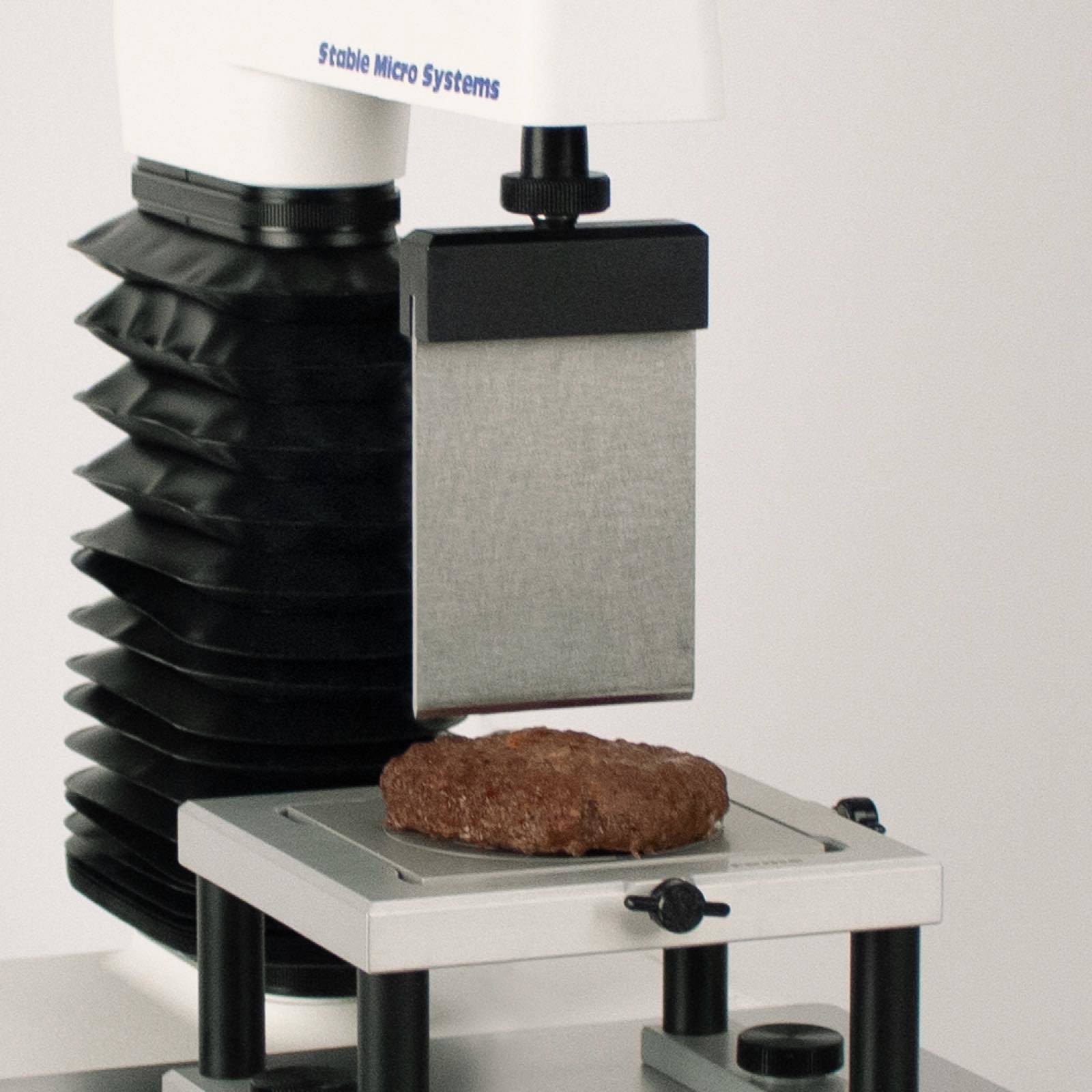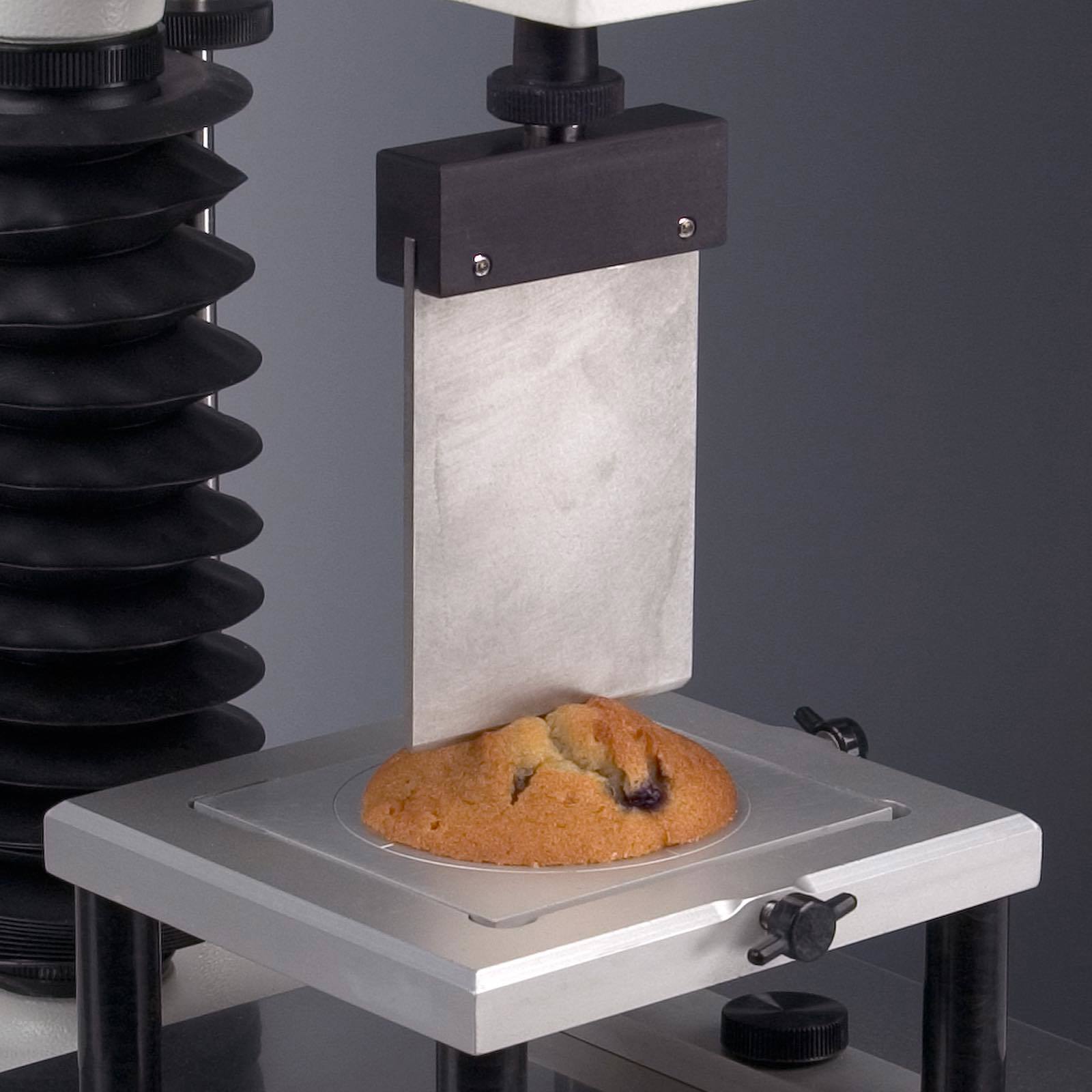How to measure chewiness/bite force

Bite force and chewiness testing: definition and importance
When you bite into a food, you perceive its hardness or firmness. While hardness/firmness is a common texture property, terms like bite, toughness, or chewiness are often used in relation to food products. Toughness or chewiness is frequently associated with meat, fish, and poultry but also applies to baked goods such as tortillas, pancakes, and pizzas.
Though chewiness may be desirable in certain foods like caramel, rare steak, or chewing gum, it can also be a negative indicator, suggesting overcooking or long storage, which may disappoint consumers. Bite force refers to the initial force applied by the teeth when biting into food, whereas chewiness reflects the sensation of sustained resistance during chewing. A Texture Analyser equipped with a knife blade simulates the biting or cutting action, providing an accurate measurement of these parameters.
Beyond food, bite force is also relevant to the dental and pet food industries. In humans, bite force is determined by the interaction of the jaw muscles, mandibles, maxillae, and teeth, and it is often used to evaluate oral health. For example, bite force has been linked to children’s dental health and overall quality of life. Understanding bite forces is also essential in fields such as dental implant development, materials research, surgical techniques, and forensic medicine.
Further example applications of bite force and chewiness testing
In food testing, the toughness/chewiness parameter is measured as the total positive area under the curve during testing, representing the total energy or "work" required to bite through or chew a product. A higher area value indicates a tougher or chewier sample. A Texture Profile Analysis (TPA) test can also be performed using a Texture Analyser, where a food sample is compressed twice to simulate a “double bite.” The test yields multiple textural properties, including hardness, springiness, chewiness, gumminess, cohesiveness, and resilience.
Here are some examples of how bite force and chewiness measurements are applied in various industries:
- Meat products testing: Assessing the chewiness and bite force of steaks, burgers, and sausages ensures tenderness and ease of consumption by measuring the force needed to bite through them.
- Gummy candies and chews: Evaluating the chewiness and bite force of gummy candies and fruit chews to ensure the desired texture by measuring the force required to bite through them to assess their softness.
- Bread and bakery products: Assessing the chewiness and bite force of bread and rolls to ensure optimal texture by measuring the force needed to bite into a sandwich roll to evaluate its crust and crumb.
- Pasta and noodle testing: Determining the chewiness and bite force of pasta to ensure it is cooked to the desired tenderness by measuring the force required to bite through spaghetti to test its al dente texture.
- Fruit and vegetable texture evaluation: Evaluating the chewiness and bite force of fruits and vegetables to assess ripeness and quality.
- Snack bars and granola products: Assessing the chewiness and bite force of snack bars to ensure proper texture and mouthfeel.
- Cheese texture testing: Evaluating the chewiness and bite force of cheeses to assess their firmness and meltability.
- Processed meat and seafood products: Testing the chewiness and bite force of jerky or seafood products like calamari rings to assess their toughness.
- Dough and dough-based products: Assessing the chewiness and bite force of dough-based items like pizza crusts and breadsticks.
In these examples, a Texture Analyser applies controlled force/distance to the food product, simulating the action of chewing or biting. The resulting data helps optimise food textures, ensuring consistent product quality and consumer satisfaction.
Typical probe/attachment used for measurement
In a typical bite force/cutting test, a sample is located beneath a blade, usually perpendicularly. The test simulates the action of biting into a food product and measuring the force and distance required to cut through/penetrate or deform the sample relating to a sample’s toughness.
A range of blade options provide a cutting edge which effectively represents a line of teeth. Stable Micro Systems’ range of blades vary considerably in size, material, thickness and sharpness. When a product is uniform (homogenous), a single blade test may be adequate for the repeatable assessment of the product.
Blades and Craft Knives
Cutting test using the Craft Knife Adapter and Blades
Cutting tests using the Blade Set
Cutting tests using a Kramer Shear Cell
However, quite often a product is non-uniform (heterogeneous) in make-up. For example, cereal bars and are of different structure throughout their length. A single cutting test may encounter a peanut, toffee piece and hard wheat piece. The same cutting test done further down the length of the product will produce a different result; this time the blade may encounter a fruit piece and a chocolate chip. The same type of explanation can be given for a piece of meat.
To assess these types of product in a more reproducible way, the recommendation is to perform a multiple shearing test (most often using a Kramer Shear Cell). This test performs 5 or 10 cutting tests within one test and therefore creates an averaging effect.
How to interpret the Texture Analyser graph
 Typical curve indicating key analysis points of a chewiness/bite force test
Typical curve indicating key analysis points of a chewiness/bite force test
When measuring bite force/chewiness, the force vs distance/time graph typically shows an undulating profile. Sharp, high peaks suggest crispness or brittleness. Multiple peaks suggest a heterogenous/variable texture. Broader, lower peaks might indicate a chewy or rubbery texture. From the graph you can observe/obtain the following:
- Work of shear
- Toughness
- Biting force
- Cutting force
- Hardness
- Firmness
A full explanation of this curve and its analysis can be accessed within Exponent Connect software. Existing Exponent users can upgrade to Exponent Connect specification.
Below is a video example of how we can help you understand curve analysis for an example property.
Key factors affecting chewiness/bite force measurement
- Temperature: The temperature of the sample can significantly influence its mechanical properties, affecting the measured chewiness and bite force.
- Humidity: Humidity levels can alter the moisture content of samples, potentially changing their texture and the force required to chew or bite them.
- Test speed: The rate at which force is applied during the test can influence the measured results, as materials may respond differently to varying speeds of compression.
- Sample positioning: Proper centring and alignment of the sample in the testing attachment ensures uniform force distribution and accurate measurements
- Absence of defects: Pre-existing defects or weak points in the sample can lead to inaccurate chewiness or bite force measurements.
- Sample thickness: The thickness of the material being tested directly affects the force required to chew or bite it
Collecting alternative measurements
Alternatively, a Texture Profile Analysis (TPA) test can measure chewiness amongst its parameters but this is from a compression test using a larger cylinder probe.
Optimising chewiness/bite force measurement and analysis: The Stable Micro Systems advantage
The Stable Micro Systems Texture Analyser excels in optimising chewiness/bite force measurements through its versatile capabilities and specialised features. Equipped with custom probes and attachments that simulate teeth, it performs a range of tests including Texture Profile Analysis (TPA), which mimics chewing action.
The Texture Analyser's high-precision measurements and comprehensive Exponent Connect software capture detailed force-distance-time profiles, enabling in-depth analysis of chewiness characteristics and bite force patterns. With customisable test parameters, it can simulate real-world chewing conditions for various food products.
The system's ability to use tools like the Kramer Shear Cell for non-homogeneous samples ensures reproducible results. Backed by Stable Micro Systems' expertise in method development and data interpretation, the Texture Analyser provides unparalleled accuracy and insight in measuring chewiness and bite force, making it the optimal choice for food researchers and manufacturers seeking to refine product textures.
Tooth-like tools for realistic bite simulation.
Detailed force-time-distance profiles.
Ability to additionally measure sound using an Acoustic Envelope Detector.
Double compression cycles mimicking chewing.
If you need help with your bite force measurement, we offer unrivalled support.
Be guided through the steps to successful testing and analysis of chewiness/bite force.











